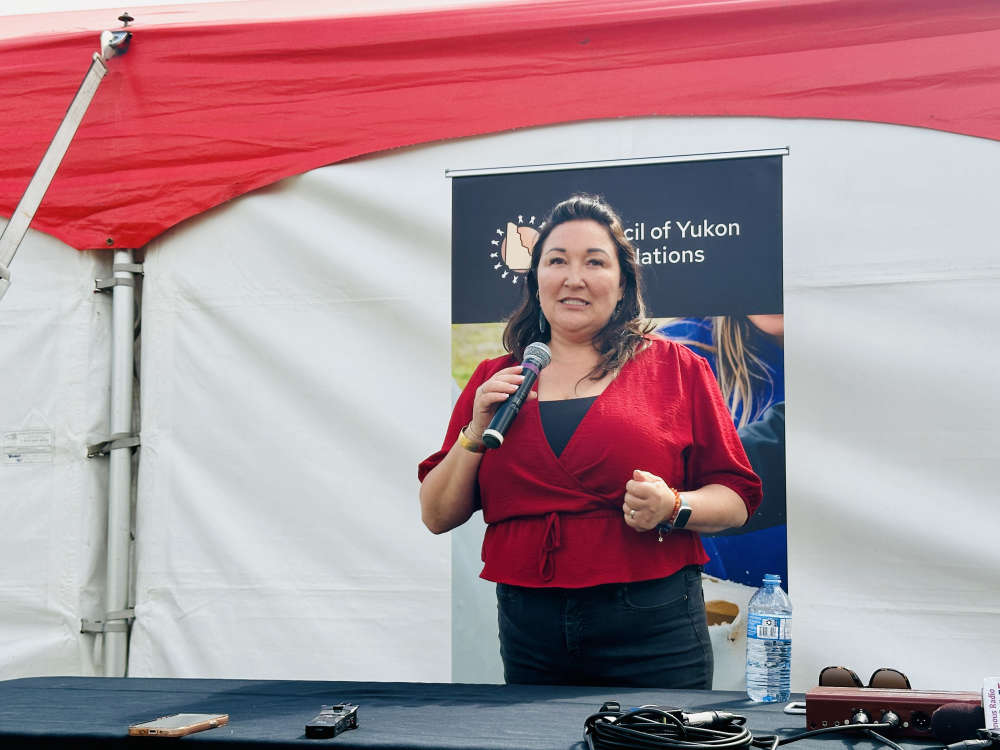
First Nation of Na-Cho Nyäk Dun consultant speaks out about government inaction.
The Government of Yukon held a technical briefing on the heap-leach failure at Victoria Gold’s Eagle Gold mine on Friday.
Four officials from the Yukon government’s department of Energy, Mines, and Resources were joined by representatives from the Worker’s Safety and Compensation Board, the Yukon’s acting Chief Medical Officer of Health, and representatives from Health and Social Services and the Department of Environment.
Media were told that when it came to specifics about the heap-leach failure, the information was not yet available.
Just before the technical briefing ended, Northland Earth & Water consultant Cord Hamilton spoke up. Hamilton says he has been consulting for the First Nation of Na-Cho Nyäk Dun for ten years, and that he and the First Nation are deeply concerned about the potential release of cyanide into the environment.
“We estimate, with the best information we have available, there is somewhere between 800,000 and a million cubic metres of cyanide solution contained in the heap that is now draining down in an uncontrolled manner,” said Hamilton. “There is storage on that site for less than half of that in secure facilities. So, that’s what’s coming. That needs to be captured or treated, or it will be released. And this is before we account for rainfall, flows from the other side of the valley, and Dublin Gulch, which is now crossed by the slide maps, itself.”
Despite the Yukon government’s panel of officials insisting that they have been working closely with the First Nation of Na-Cho Nyäk Dun, Hamilton says that there is plenty more that can and must be done.
“What do the First Nations feel? They are dismayed. They are angry. And they should be,” said Hamilton. “This is a catastrophe that is unfolding before us, so we really want to see a higher level of response.”
“We know more is coming at us. Makeshift dams are not the answer. Really significant action is required.”
Hamilton acknowledged that it may take time to find cyanide in water samples from the area, but looking for dead fish in the area would be a much faster indicator of a problem. There was no word from officials whether they were looking for fish affected by cyanide.
In a media release Thursday afternoon, White River First Nation voiced full support of the First Nation of Na-Cho Nyäk Dun and called for a public inquiry into the heap-leach failure. No such inquiry was confirmed at the technical briefing.
While the Yukon government says the risk of cyanide in drinking water is very low, residents in the area should be aware that dizziness, headache, nausea and vomiting are common in cyanide exposure.


 Math'ieya Alatani elected CYFN Grand Chief
Math'ieya Alatani elected CYFN Grand Chief
 Watson Lake man charged in firearm robbery
Watson Lake man charged in firearm robbery
 House fire in McIntyre contained
House fire in McIntyre contained
 RCMP plane crash caused by faulty sensor: TSB report
RCMP plane crash caused by faulty sensor: TSB report
 New Fireweed Mental Health unit opens at Whitehorse General Hospital
New Fireweed Mental Health unit opens at Whitehorse General Hospital
 Traditional learning camp opens at Whitehorse school
Traditional learning camp opens at Whitehorse school
 Yukon Schools introduce online registration for bus service
Yukon Schools introduce online registration for bus service
 Yukon Government unveils progress in healthcare transformation with 2024 Putting People First annual report
Yukon Government unveils progress in healthcare transformation with 2024 Putting People First annual report
 Whitehorse Emergency Shelter unveils New Artwork celebrating Yukon First Nations culture
Whitehorse Emergency Shelter unveils New Artwork celebrating Yukon First Nations culture
 Former Whitehorse City Councillor Ted Laking announces bid for Yukon Party nomination in Porter Creek Centre
Former Whitehorse City Councillor Ted Laking announces bid for Yukon Party nomination in Porter Creek Centre
 Yukon Government seeks applicants for new Health Authority Board
Yukon Government seeks applicants for new Health Authority Board
 Canada Post strike looms, Yukoners brace for disruption
Canada Post strike looms, Yukoners brace for disruption
 Driver charged in fatal collision that killed Yukon Government Deputy Minister and injured Minister
Driver charged in fatal collision that killed Yukon Government Deputy Minister and injured Minister
 Yukoners encouraged to apply for Northwestel's Northern Futures Scholarship Program
Yukoners encouraged to apply for Northwestel's Northern Futures Scholarship Program
 City of Whitehorse summer transportation maintenance work underway
City of Whitehorse summer transportation maintenance work underway
 Yukon Government seeks input on new downtown public school
Yukon Government seeks input on new downtown public school
 Indigenous leadership takes centre stage: Rebecca Chartrand and Mandy Gull-Masty appointed to key cabinet roles
Indigenous leadership takes centre stage: Rebecca Chartrand and Mandy Gull-Masty appointed to key cabinet roles
 Whitehorse prepares for Annual 20-Minute makeover
Whitehorse prepares for Annual 20-Minute makeover
 RCMP conducting training exercises on Schwatka Lake
RCMP conducting training exercises on Schwatka Lake
 CYFN makes history as winner of prestigious Arctic Inspiration Prize
CYFN makes history as winner of prestigious Arctic Inspiration Prize